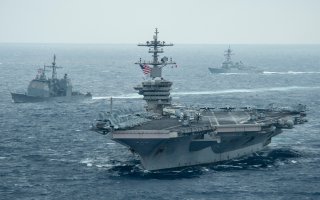Are China's Bases in the South China Sea Really "Unsinkable Aircraft Carriers"?
In the event of war between the United States and China in the western Pacific region, the outposts likely would be important targets for the Americans.
Here's What You Need to Remember: “Rumors suggest the new islands’ concrete is crumbling and their foundations turning to sponge in a hostile climate. And that is before considering what a direct hit from a super-typhoon might do.”
China’s island outposts in the China Seas might have a major weakness.
Since 2013 the Chinese government has dredged and mostly destroyed ecologically delicate reefs in disputed waters in order to build seven major military bases complete with ports, airstrips and radar and missile installations.
The islands function as unsinkable aircraft carriers and help to cement Beijing’s claims on waters rich with fish and minerals, waters that neighboring countries also claim.
“If the terraforming no longer makes headlines, it is because it is largely complete,” The Economist stated.
Perhaps the most important installations sit on the Fiery Cross, Subi and Mischief reefs in the Spratly island group. Vietnam, The Philippines, Malaysia, Brunei and Taiwan all also claim the Spratlys.
Between 2013 and 2016, huge construction vessels pulverized the reefs in order to create the raw materials for the bases. The dredger Tianjing alone shifted 4,500 cubic metres of materials every hour, “enough to nearly fill two Olympic-size swimming pools,” according to the Hong Kong South China Morning Post.
Beijing claims it has begun restoring the reefs it destroyed, but it’s unclear how effective restoration efforts might be. Marine biologist John McManus at the University of Miami said that dredging “kills basically everything” living around coral reefs.
To the Chinese Communist Party, the new bases were worth the environmental cost. The installations “allow China to control the entirety of the South China Sea in any scenario short of all-out war with the United States,” The Economist explained. “The new port and resupply facilities are helping China project power ever further afield. Chinese survey vessels look for oil and gas in contested waters.”
In 2014 China deployed an oil platform in Vietnam’s exclusive economic zone, leading to a stand-off between Chinese and Vietnamese forces. The Chinese eventually removed the first platform, only later to deploy a second one.
“Yet not everything is going China’s way,” The Economist added. “Rumors suggest the new islands’ concrete is crumbling and their foundations turning to sponge in a hostile climate. And that is before considering what a direct hit from a super-typhoon might do.”
More significantly, neighboring countries are resisting Chinese pressure to develop gasfields that lie within their [exclusive economic zones] jointly. Even though The Philippines agreed in principle to one joint development, a formal agreement to that end has yet to be signed.
Nor has China prevented foreign oil companies from working with other littoral states. The rig Chinese vessels harried in Vietnamese waters is operated by a Russian state enterprise, Rosneft, even though Russia is supposedly a close friend of China’s.
The island bases’ uncertain future hasn’t deterred China from heaping additional capabilities on their potentially fragile infrastructure. In November 2019 a surveillance blimp for the first time appeared on Mischief Reef.
“A radar-carrying aerostat [blimp] would provide a very capable, but also a relatively cheap option for monitoring various activity around Mischief Reef, as well as potentially cueing surface-to-air and anti-ship missiles to engage potential threats,” Joseph Trevithick reported at The War Zone.
The elevated position would help increase the overall range of the system substantially, which would be especially valuable for spotting low-flying threats, such as cruise missiles or swarms of small unmanned aircraft as they crest over the horizon. Though China is steadily improving the defenses on its man-made islands, low-flying cruise missiles certainly represent a continuing threat to its outposts.
Aerostat-mounted radar systems can also remain aloft for long periods and, depending on their exact capabilities, in many types of weather, making them far more cost-effective and easier to maintain than manned aerial sensor platforms. They can also fly much higher, and therefore have far longer line-of-sight to the horizon, than even large mast-mounted ground-based radars.
The U.S. Navy periodically maneuvers a warship close to one of China’s island bases in order to assert American forces’ legal right to sail through international waters. In the event of war between the United States and China in the western Pacific region, the outposts likely would be important targets for the Americans.
David Axe serves as Defense Editor of the National Interest. He is the author of the graphic novels War Fix, War Is Boring and Machete Squad. This article first appeared last year.
Image: Reuters.

